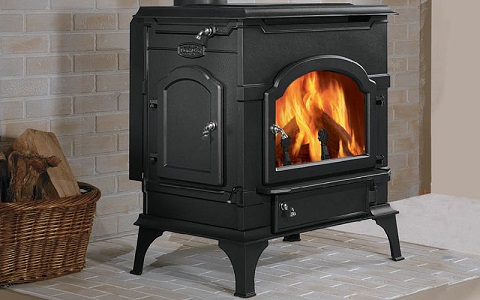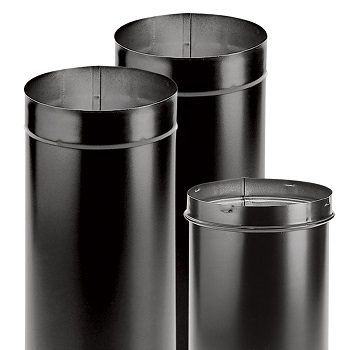
Installing a wood-burning stove can be very simple, and can be done in no time at all. All it takes is a few easy-to-follow steps to get your stove up and running flawlessly. Though it can be a pretty straightforward task, if you don't have the proper infrastructure in place (hearth, venting, etc.), it can be a fairly daunting task requiring a large time investment. Read on for more information abouthow to install a wood-burning stove。
Before we get to the tutorial, be aware of one of thebest-kept secrets at PlumbersStock。We offer lots of discount fireplace options, as well as parts and hearth accessories. You just have to belogged into see them。登录后,您将ee a lot morefireplace products here。
This step is very important. You not only want to find a place in your home where your stove will look good, but you have more to mind than that. Here are some things to consider while you are looking for a proper location for your wood-burning stove.
You cannot install a wood-burning stove in your home without a chimney. It has to be a chimney that meets building code requirements as well. You can't just install a stove with metal piping going out the window. You have to use a UL-approvedStainless Steel Class "A" insulated chimneyor a sound masonry chimney. Here are some of the ways you can install a chimney in your home.

There are2 basic waysto vent a wood-burning stove,(1) straight up and out the ceilingor(2) out the wall and along the side of the house。There are pros and cons to either choice. But there are some common denominators to both.
Because a large amount of heat goes up the chimney, using a single wall stove pipe (to the ceiling box) and a damper is the best way to channel this heat.
Venting a Chimney Straight up through the ceiling isthe quickest route to vent your stoveand maybe the least expensive. Once you vent your stove pipe up to the ceiling box, you need to start using atriple wall pipeto finish the chimney. The triple wall pipe is designed for wood stoves. It comes in different lengths that are measured in 1-foot increments. It can vent through the roof with the least amount of clearance possible. Check your local code, butmost locations only require 1-2 inches of clearance三间墙管道和任何易燃材料l. This means smaller holes to cut and more surfaces to utilize with yourroof jack。Your roof jack is the next part of your Chimney. This part is tricky, and you might want to talk to a roofer for tips, but it is essential. A roof jack keeps water out of your house, helps to hold the chimney pipe upright and helps to support the pipe during windstorms.
Finally, you will need avented top。Once you have vented your triple wall chimney pipe to the proper length (again, check your local code but typically 4’ away from your roof. You’ll need to compensate for your roof pitch to double-check the distance), you’ll need to top it off with a vented top. Vent tops are designed tokeep the bigger sparks from blowing into the airand keep moisture and critters from getting in. If you are using wood with a lot of pitch, you will need to keep an eye on the screen surrounding your vent top. It tends to clog up with creosote. If this happens, it will not vent the smoke properly and also becomes a fire hazard.
If you decide not to mess with cutting holes in your ceiling and roof, your other option is tovent your stove out the side。In this case, once you have vented your black stove pipe out the side of your home and into your transition box, you can do one of two things.Triple wall pipeup the side of your home, or amasonry chimney砖。砌体烟囱给经典look and feels to your home, and if you know how to lay it, it can be relatively inexpensive. You will probably want to stick with the triple wall pipe idea if bricklaying is not your thing. It can be boxed in and then sided or stuccoed to match your current exterior. It is fairly simple to run a triple wall pipe, but it can be quite expensive at around $80 a foot. As mentioned before, you will need to pipe above the roof and use a vented top, so don’t forget to factor those things in as well. Wall straps are also required for installing triple walls outside your home. These clamp onto the pipe to hold it fast and screw to the wall of the house for stability. A typical wall strap for 8-inch triple wall pipe runs about $20 online and should be installed about every 5 feet or so.
It might sound daunting to contemplate all this, but once it is installed, a wood-burning stove could be your saving grace if you ever lose power on those cold winter nights, and the security you will feel when you are done will be worth all the work and effort you spend. Building a chimney is a very important process when installing a wood-burning stove. If your home doesn't already have a chimney built-in for your wood-burning stove, make sure you know all the regulations about installing a chimney before you start your process. This is wise, not only for legal but insurance reasons.
Once you have identified a proper location and made sure your chimney is up to code, you can then install your wood-burning stove. This particular step is pretty simple, though arduous, because you are dealing with a heavy object. You have to place your stove in the location you want it and make sure all the metal heating tubes are connected correctly. Be sure to follow your owner's manual, which comes with the stove, to ensure you aren't missing any steps. Once you have done this, you are then ready to use your new stove.
A wood-burning stove can be a lot of fun. It brings warmth and comfort to a home on a cold winter's night and is a great place to gather as a family. By doing your part to install your stove correctly, you are taking the steps needed to keep you and your loved ones safe and out of harm's way. Always double-check to make sure your wood-burning stove meets construction code requirements and is installed properly. Thank you for reading how to install a wood-burning stove.
Related resources:
Benefits of a Wood-Fired Stove


